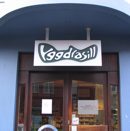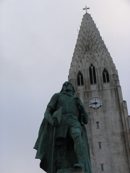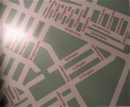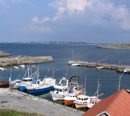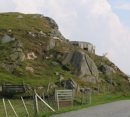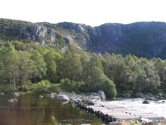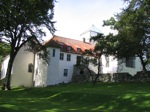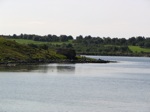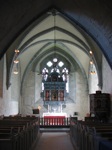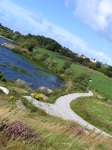On my way back to Boston I’m staying two nights in Reykjavík. I’ll takes some notes while I’m here and post them when I get back in town:
Sept 6
– In only a few hours this island has really caught my interest. However, I clearly need to come back with a whole lot more money. Unless you just want to hit the “blue lagoon” heating swimming area on the way from the airport, be prepared to rent a car or spend serious money to get to any of the beautiful areas on all the postcards. Come to think of it, the same is true for Norway.
– Even in the short fifty or so kilometers from the airport to Reykjavík and the view from the edges of town I’m already fascinated by the Icelandic landscape. In some areas it looks like the tundra of Northern Norway, in others the rocky but bright green grassland of Jæren south of my hometown. In some places along the coast it is all rocks covered with lichen and mosses of many colors. Barren and pointed hills rise out of nowhere, and you can catch glimpses of massive asteroid crater like pits of dark sand, or shaded black fields dotted with bright white pillars of steam. From the town’s harbor you can see a towering mountain hanging over the waters edge off to the North. That mountain looks so familiar, as if it were a cliff along one of the fjords back in my own Rogaland county. However, it seems darker and somehow more impressive. When I returned to my room after an early evening walk I caught a glimpse of it again in the distance, but only as a completely black background to the city, disappearing into a soft blanket of white clouds above. Everything contributes to a kind of desperate but somehow empowering feeling of loneliness, which I really find moving. Like I said, I really need to return with more money so I can visit the many different areas of the island and perhaps hike some of its hills. As for a place to live though, I think I would miss the forests too much.
– Reykjavík, or at least the center of it, doesn’t feel any bigger than any medium-sized Scandinavian fishing town, but imagine if you will a medium-sized fishing town where everyone dresses way cooler than you.
– Laugavegur The “Main shopping street” (which they kindly announce in English on signs at either end) Laugavegur reminds me a lot of the main shopping street in Sandnes outside my hometown. It’s cute, but not exactly impressive. There are, however, a number of cute coffee shops, fancy clothes stores, and delicious smelling Thai restaurants.
– Internet The “Kaffi vín” towards the eastern end of Laugavegur has an unprotected open wireless network, you can download your email here from the pavement outside. There are lots of internet cafes around but why pay?
– Gothic Is it the “desperate but somehow empowering feeling of loneliness” I was talking about the reason Reykjavík seems to be a mini-gothic capital of the world? Or is there just some kind of gothic get-together going on this week?
– Food Icelandic bread isn’t the greatest, but otherwise the stores are stocked with many if not most of the same things (and in many cases even brands). Lots of yoghurt products…yummm… Prices in the grocery store ranges from (Norwegian prices +10%) to (Norwegian Prices +100%), that is to say, expensive.
– Icelandic, with its close connection to Old Norse, is easily one of the most bad-ass languages in the world. I also feel like I’m in some kind of weird drugged dream whenever I hear it spoken. Often times I catch the beginning or end of a sentence or a conversation and I could swear they are speaking regular Norwegian. Then when I tune in for the rest, their perfectly understandable speech degenerates into complete nonsensical combinations of familiar sounds, which just adds to my fascination. Add to this the fact that Icelandic gains instant sexiness from its frequent use of the letter ∂, with a slash through it. Oh ya, the funky p (which I can’t figure out how to type on this keyboard) is also kind of neat but ∂ is still my favorite and I think we should all reintroduce it into our own alphabets.
Sept 7
– Bicycle Rentals and Hitler You can rent a bicycle at Hverfisgata 50, which runs parallel to Laugavegur. They rent out mountain bikes with a lock included for 2000kr per 24 hours which I found to be great if you want to bike around the town’s back streets and visit its parks and museums. I would have used it for a day ride out of the city but today the weather was terrible in the morning. The door to the mountain bike store had strange yellow index cards wedged into various posters hanging there. If my Icelandic-guessing engine is functioning, each card posed strange open-ended questions like, “Is Israel part of Europe?” and the more bizarre, “Was Hitler evil?” (Var Hitler vondur?). This reminds me of the kind of tactic used by any cause trying to problematize some widespread idea, e.g. “Did evolution happen?”
–Back-streets and Houses I spent the morning biking around the west and northwestern areas of Reykjavík. The older houses often have a pretty normal scandinavian color and design found in other towns, but as to be expected there is much less wood. Instead, what looks like wooden boards from a distance on closer examination turns out to be sheets of metal siding. Newer houses and larger structures in the town mostly seem to be made of stone. There is a surprising amount of graffiti in a town of this size, both downtown and in the neighborhoods. There is much the same in many places in Stavanger, Oslo and other Scandinavian areas but I somehow expected there to be less here. There quite a high density of schools and lutheran (the state religion) churches in the city given its small size. They also have quite a few parks, both in the interior of the city and along its coastline.
– The Culture House The Culture House can be found at Hverfisgata 15. It houses an exhibit of Iceland’s prize medieval manuscripts, information on the history of the Sagas, and an area dedicated to the history of book writing. There are also temporary exhibits on the 2nd and 3rd floors, a gift shop and a small cafe.
The “Medieval Manuscripts: Eddas and Sagas through the ages” on the 1st floor was wonderful. It gave an interesting overview of the history of the sagas, and had many of the rare manuscripts on display, but at least half of the exhibit was historiographical. There were sections on the role of these various texts in the romanticism and nationalism of Iceland and the North, their appropriation by the Nazis for its Aryan crusade, role in pop culture, and even a description of how the street names and layout in Reykjavík were structured to mirror the sagas and nordic myths (see separate posting). Translations of captions into English were available throughout with Danish also in the manuscript display rooms (many of these manuscripts were returned by Denmark in the early 1970s). Most of the manuscripts on display are early 13c and almost all in Old Norse. Latin works were quite rare in Iceland, which probably has to do with the particular relationship between Christianity and society on the island and perhaps the generally non-Latin educated nature of much of the writing class.
I really think the exhibit was great for several reasons: 1) It had a tight narrative which combined history and historiography in a way that the visitor never felt patronized. 2) It combined informational captions, maps, displays, lighting and artifacts skillfully. However, it also made good use of documentaries shown by TVs, the occasional iMac set up for visitors to check out online resources (For example: Stofnun Árna Magnússonar á Íslandi (If you understand Icelandic, check out their online section of Folklore recordings here and their Digital Manuscript Collection) and a flash story site called “Europe of Tales“). Perhaps the only thing I could complain about was the use of some images without providing context. For example, when describing the medieval parliament, they used a painting depicting it made during romanticist movement of the 1800s. That would have been nice to include for context, because the image and the way it portrays the parliament are useful in understanding the nationalist idealization of Iceland’s independent commonwealth period prior to its subordination to the Norwegian (late 13c) and later the Danish crown (14c).
Currently the 2nd floor has a fantastic exhibit “Reflections on Iceland” which I really enjoyed. It had put maps and travel literature about Iceland on display from throughout the centuries. It was interested in giving the visitor glimpses about what others had to say about the island and its people throughout the ages, both good and bad. The descriptive captions were in Icelandic but along the wall was a packet of laminated sheets with English translations of everything. What made the displays especially effective was that they lined up the works roughly chronologically and put works which referred to each other in juxtaposition. For example, one caption would describe how one writer, who may never have actually been to Iceland, said this, that or the other, then next to it we would find the next publication by some author determined to refute the slanderous writings of his predecessor. I only wish that much of this display’s information and captions were available online, something I will have to check when I post this and get online.
The 2nd floor also had an interesting exhibit dedicated to the Mormons of Iceland and, in particular, the migration of over 400 Icelandic Mormons to Utah. It followed their history from conversion to their long and troubled journey via England to the United States.
– Outdoor Picture Exhibit Throughout the downtown area there is currently an outdoor picture exhibit. These are a great way to give visitors and residents a feeling of connection to the past. The pictures dated from around 1905 through to the 1970s and offered scenes of importance and the every day often with interesting trivia added about the development of a particular sector of the city, and important events that had left their mark by pointing out things in the background.
During World War II Britain invaded Iceland and would have done the same to Norway if the Germans hadn’t gotten there first. They later turned control over to the US, which became the only military defense for the island until this year (the American Icelandic Defense force is shutting down completely this month, I believe). In one picture around the time of the 1944 declaration of an Icelandic republic, which finally severed the final tie that the island had to the Danish crown, I was surprised to learn that the Danish king, then in his own German-occupied Denmark, actually sent a letter of congratulations to the Icelandic people. It is not the benevolence of the king which surprises me, there isn’t much he could have done about it, but rather that he could do such a think while he was in a post-1943 (when German control strengthened in Denmark) occupied Denmark sending congratulations to the inhabitants of an island occupied by his occupier’s enemy.
– Kaffitár The rain compelled me twice to seek the comfort of coffee shops. I spent a few hours today continuing my reading the second volume of Ingar Sletten Kolloen’s biography of Knut Hamsun. In one very nice coffee shop on Laugavegur, Kaffitár (a chain I also saw at the airport and shopping mall, unless it just means generic cafe), I was surrounded by Macintosh users downloading their internet from the cafe’s free internet connection. If you buy coffee, and you are faced with several options, the one starting with “Sel…” something is “Dark Roast”
– The National Museum After more biking around in the early afternoon I paid a good 3 hour visit to Iceland’s National Museum. My notes on this got long enough for a separate posting which I’ll upload separately.
– See some pictures from my two days in iceland via the picture page, or directly here.
UPDATE: Nathanael of the Rhine River blog has a few notes on the Gothic architecture of Reykjavik.



